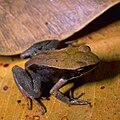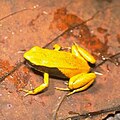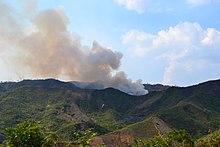
Poison dart frog is the common name of a group of frogs in the family Dendrobatidae which are native to tropical Central and South America. These species are diurnal and often have brightly colored bodies. This bright coloration is correlated with the toxicity of the species, making them aposematic. Some species of the family Dendrobatidae exhibit extremely bright coloration along with high toxicity, while others have cryptic coloration with minimal to no amount of observed toxicity. The species that have great toxicity derive this feature from their diet of ants, mites and termites. However, other species that exhibit cryptic coloration, and low to no amounts of toxicity, eat a much larger variety of prey. Many species of this family are threatened due to human infrastructure encroaching on their habitats.

Stumpffia is a genus of microhylid frogs that are endemic to Madagascar. They are mostly brown frogs that typically live among leaf litter. S. contumelia has a snout–vent length of about 8–9 mm (0.31–0.35 in), making it one of the world's smallest frogs, and several others in the genus are only slightly larger. The largest species is no more than 28 mm (1.1 in).

Mantellinae is a subfamily of frogs in the family Mantellidae. These frogs are native to Madagascar and Mayotte. The species vary in size from under 25 mm to over 100 mm. The subfamily is most famous for the genus Mantella, which contains species that superficially resemble poison dart frogs of the tropical Americas, and have converged on similar aposematic colouration and toxins. As of 2 May 2016, there are 128 described species in this subfamily, but several more are described each year.

Aglyptodactylus is a genus of frogs in the family Mantellidae. These frogs, sometimes known as the Madagascar jumping frogs, are endemic to Madagascar. Systematic revisions of the groups were published in 1998 and 2015. Six species are currently recognized.

Leioheterodon is a genus of harmless pseudoxyrhophiid snakes found only on the island of Madagascar. Three species are currently recognized. Common names include Malagasy hognose snakes, Malagasy brown snakes and Malagasy menarana snakes.

Sanzinia madagascariensis, also known as the Madagascar tree boa or Malagasy tree boa, is a boa species endemic to the island of Madagascar. It was once considered conspecific with the Nosy Komba ground boa. Like all other boas, it is non-venomous.

The golden mantella is a small, terrestrial frog endemic to Madagascar. It has an extremely restricted distribution in three distinct areas centered on the town of Moramanga - Beparasy and Ambohibary Communes, Torotorofotsy Wetland northwest of Andasibe, and in the area of Ambakoana. Mantella aurantiaca is one of Madagascar's most threatened amphibian species due to its limited distribution in an area under tremendous anthropogenic pressure. It may also be threatened by over-collection for the pet trade.

Phyllobates is a genus of poison dart frogs native to Central and South America, from Nicaragua to Colombia. There are 3 different Colombian species of Phyllobates, considered highly toxic species due to the poison they contain in the wild.
Xenotyphlops is a genus of snakes, the only genus of the family Xenotyphlopidae, comprising two species found only in Madagascar. These snakes are also known as the Malagasy blind snake.
Xenotyphlops grandidieri is a species of blind snake in the family Xenotyphlopidae. The species is endemic to Madagascar. There are no subspecies that are recognized as being valid.

Mantella baroni is a species of small poisonous frog in the family Mantellidae.
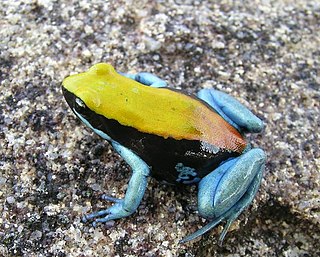
The blue-legged mantella is a small species of frog in the family Mantellidae. It is endemic to the Isalo National Park and areas south of it in Madagascar, a range it shares with the rainbow frog. Both are locally common, but endangered due to habitat loss and over-collected for the pet trade.

The climbing mantella is a species of diurnal poison frog of the genus Mantella that resides in the subtropical regions of northeast Madagascar. Although it spends a significant amount of time in trees or bamboo forests, this frog species is not fully terrestrial and actively seeks areas with a water source.

Mantella madagascariensis, common names Malagasy painted mantella, Madagascan mantella, Madagascar golden frog, Malagasy mantella and painted mantella, is a species of frog in the family Mantellidae.

Rhombophryne is a genus of microhylid frogs endemic to Madagascar. It is currently estimated to include more than 23 species, but only 20 of these are currently described. The common name 'diamond frog' has been proposed and used for members of this genus.
The golden poison frog is a poison dart frog in the family Dendrobatidae endemic to the Pacific coast of Colombia.
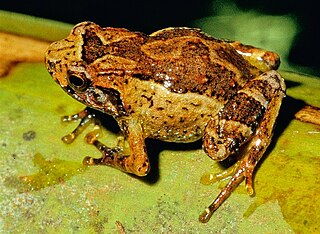
Anodonthyla jeanbai is an arboreal species of frogs in the family Microhylidae. It is highly polychromatic, and has an extremely isolated phylogenetic position, showing no clear relationships to any other members of the genus Anodonthyla. It is found only in a small higher-elevation area in Madagascar.

Plethodontohyla alluaudi is a frog belonging to the Madagascar-endemic subfamily Cophylinae of the family Microhylidae. It is endemic to southeastern Madagascar. It is a terrestrial and fossorial frog that occurs in rainforest, including littoral forest. Despite being locally abundant, it is a difficult frog to find.

Leioheterodon madagascariensis, the Malagasy Giant Hognose or Madagascar Giant Hognose, is a harmless species of snake that can be found in Madagascar, Nosy Be, Nosy Sakatia and Comoros Islands. They can grow from 130 to 180 cm. It is thought by some to have been introduced to the Grande Comoro.

The Sanziniinae are a subfamily of boid snakes containing four species endemic to the island of Madagascar. Common names include Madagascar boas and Malagasy boas.




